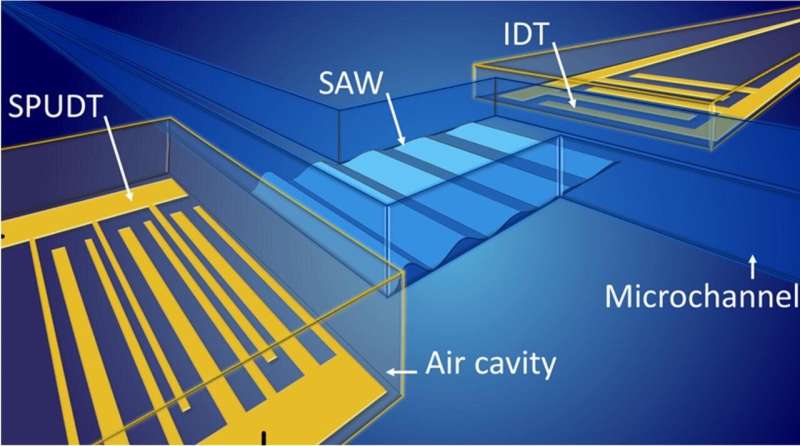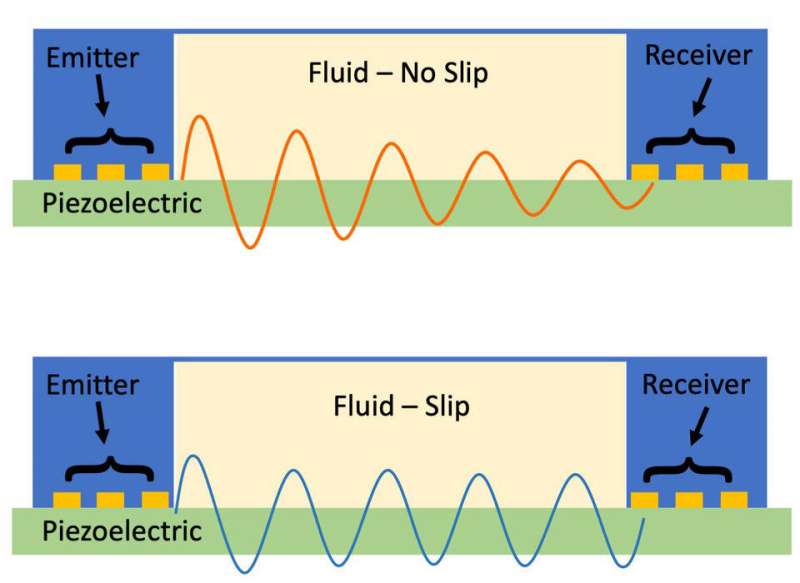
Researchers at the National Institute of Standards and Technology (NIST) have discovered a potential source of error when using acoustic waves to measure the properties of fluids such as blood. Their discovery raises the possibility of more accurate diagnostic tests for certain types of blood cancer and more precise sorting of blood cells.
All acoustic waves, including ultrasound, create regions of alternating high and low pressure in a medium such as air, water and other fluids such as blood. Researchers frequently use them to study the properties of small volumes of "microfluids," those confined to vessels no wider than the thickness of a credit card.
To measure the properties of a microfluid blood sample, researchers use ultrasound waves of a known frequency and energy, generated just beneath the bottom wall of the vessel by a piezoelectric crystal, a material that can convert the flow of electricity to acoustic waves. The waves that penetrate the fluid ride mostly along the bottom surface, between the liquid and the wall. After the waves exit the fluid, scientists detect any loss of energy or shift in frequency of the waves. These measurements can reveal properties that are crucial for measuring the flow of blood, which can be dangerously slow in some blood cancer patients. Acoustic waves can also sort cells in whole blood.
Biomedical researchers and oncologists have a particular interest in measuring a microfluid's viscosity. Sometimes referred to as a fluid's thickness, viscosity is more precisely defined as a measure of the resistance of a fluid to shear. For example, molasses resists shear much more than water, and is about 5,000 times more viscous, explaining its slow-pouring behavior.
People with certain types of blood cancers, including multiple myeloma, leukemia and Waldenström's macroglobulinemia, may have blood plasma so viscous that it can interfere with the circulation of blood throughout the body. To assess this condition, known as hyperviscosity syndrome, physicians rely on a variety of measurements such as whole blood and blood serum viscosity.
For acoustical measurements of these properties, the NIST research team discovered that an often-ignored property known as slip should be taken into account to ensure their accuracy. Slip refers to the motion of the microfluid as it slides against the solid walls of its container. The slip in a microfluid, the researchers found, is similar to that observed in a familiar party trick, when someone yanks a tablecloth, leaving behind the dishes and silverware. (Without slip, the tableware would come crashing down with the tablecloth.)
A microfluid experiences slip simply due to the flow of fluid against the wall of its container. But when acoustic waves enter the microfluid, they introduce a second type of slip. The periodic motion of the acoustic waves—its cycle of crests and troughs—causes the surface of the microfluid closest to the wave source to move ever so slightly back and forth against the container wall. This sideways motion is indeed tiny—the movement amounts to no more than about 15 molecules in length.

In a series of experiments, Aurore Quelennec (now at Teledyne Technologies in Canada), along with NIST scientists Jason Gorman and Darwin Reyes, discovered that the presence of this acoustic slip prevents microfluids from absorbing as much energy from acoustic waves as they would otherwise. The team's study ruled out several other factors, such as surface tension and roughness of the container walls, that might also have diminished the amount of acoustical energy absorbed by the microfluid, Reyes noted.
"Slip due only to fluid flow is well understood," said Gorman. "However, as many new classes of acousto-fluidic devices emerge in bioscience applications, such as cell sorting, lysis (breaking down the cell membrane) and the measurement of fluid properties, acoustic slip is becoming more and more important to characterize," Gorman said.
The researchers were surprised to find that the acoustic slip between the fluid and the container wall resembles that of one solid rubbing against another, which is governed by the Amontons-Coulomb friction laws. The resemblance is important because it will allow researchers to model acoustic slip based on a more familiar and better studied phenomenon.
If acoustic slip at the liquid-solid interface is ignored, the change in the absorption of the acoustical waves would be entirely attributed to the physical properties of the microfluid through which they traveled. Although the researchers have not examined how their finding might play out in acoustical studies of blood or other biological material, acoustic slip may lead to a less accurate measure of viscosity.
Fluid slip can also affect the ability of acoustic waves to sort cells within a small sample of whole blood. In this technique, the waves are employed to push cells within the blood. For a given energy and intensity of the acoustic waves, different types of blood cells will be pushed by different amounts according to their size and other physical and mechanical properties, resulting in a separation. But because slip reduces the transfer of energy and pressure, the quality of the sorting process will be diminished.
"If the true role of slip is recognized and accounted for, it will enable acoustical measurements in microfluids to achieve the highest accuracy possible and advance future measurements in biology and medicine," Reyes said.
The researchers reported their findings online in the March 22 issue of Nature Communications.
Explore further
This story is republished courtesy of NIST. Read the original story here.
Citation: NIST discovery could increase accuracy in measuring blood flow for cancer diagnosis, other applications (2022, March 23) retrieved 23 March 2022 from https://ift.tt/CsVelcG
This document is subject to copyright. Apart from any fair dealing for the purpose of private study or research, no part may be reproduced without the written permission. The content is provided for information purposes only.
"flow" - Google News
March 23, 2022 at 08:58PM
https://ift.tt/CsVelcG
NIST discovery could increase accuracy in measuring blood flow for cancer diagnosis, other applications - Phys.org
"flow" - Google News
https://ift.tt/Im5nH67
https://ift.tt/TpxSvPr
Bagikan Berita Ini














0 Response to "NIST discovery could increase accuracy in measuring blood flow for cancer diagnosis, other applications - Phys.org"
Post a Comment